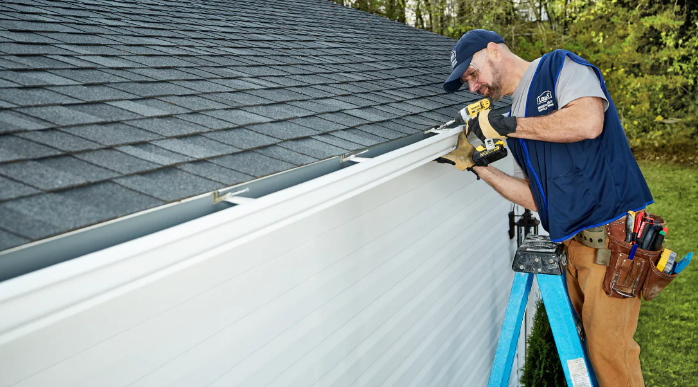If you’re like many homeowners, the thought of installing your own aluminum gutters can be daunting. However, with some knowledge and preparation, it can often be a relatively easy task to take on by yourself. By having an understanding of the key aspects that go into gutter installation and ensuring that all safety precautions are taken, you’ll soon have sleek aluminum gutters installed along your roof edges in no time! In this blog post we will explore five key aspects of aluminum gutter installation including tools required, planning & measurement techniques, material considerations, cleaning methods and safety best practices so you can complete the project safely and efficiently.
1. Selecting the Right Material:
Selecting the right material for gutter installation is an important decision when it comes to home ownership, as the right material can make all the difference in protecting your home from water damage. There are a number of materials available on the market, including aluminum, steel, and vinyl, each with their own advantages and disadvantages. Aluminum gutters are lightweight and cost-effective but may dent easily; steel gutters are heavier and more durable but conduct heat more quickly; and vinyl gutters are inexpensive and easy to install but may not last as long as other materials. When considering which material to use for gutter installation, homeowners should take into account factors such as their budget, climate, property size, local building codes, maintenance requirements and aesthetics. Depending on where you live, you may be required to use certain types of materials for gutter installation due to local regulations or building codes. Furthermore, if your property is located in a particularly high rainfall area or near a coastal area prone to salt spray corrosion then you should consider using a more heavy-duty material such as stainless steel or copper gutters to ensure maximum durability over time. Additionally, it’s important to factor in the need for maintenance when selecting your gutter material; some materials require regular cleaning while others are self-cleaning or maintenance-free. Finally, aesthetic value should also be taken into consideration when selecting your gutter material – different colors or textures can drastically alter the curb appeal of your home. In conclusion, there is no one-size-fits-all solution when it comes to selecting the right material for gutter installation; careful consideration must be given depending on the unique needs of each individual homeowner.
2. Understanding Pitch & Slope:
When it comes to installation, one of the most important factors is understanding how much pitch (or slope) needs to be applied so that the water flows properly down into the downspout instead of spilling over the sides or backing up in your gutters during heavy rains. Generally speaking, a pitch of 1/4 inch per foot is sufficient for most residential applications; however this may vary depending on local regulations or specific circumstances with your roof or house design. It’s best practice to consult with an expert if you’re unsure about this aspect before proceeding with installation for best results!
3. Gutter Size:
Gutter size is an important factor to consider when installing gutters. The right size gutter will carry water runoff away from your home’s foundation, preventing flooding and other costly damages that can occur due to overflowing or undersized gutters. When selecting the correct size gutter for your home, you should take into account the amount of roof area, the amount of rain your area receives, and the pitch of your roof. For instance, if you have a larger roof with a steeper pitch, then a 5-inch gutter may be more suitable than a 4-inch one. Additionally, if you live in an area that experiences heavy rainfall regularly, then having a larger 6-inch or even 7-inch gutter could be the better option for optimal protection against water damage. Furthermore, it is important to consider using high-capacity downspouts along with the appropriate sized gutters to ensure that rainwater is siphoned away quickly enough without overflowing out of the gutters. Properly sized gutters are also essential for preventing debris and leaves from clogging up and causing blockages in your system as this can also lead to water damage. Ultimately, finding the right size gutter and downspout combination is essential for safeguarding any home from potential water damage while still providing an attractive aesthetic look.
4. Downspouts & Extensions:
Downspouts are an integral piece of any gutter system since they’re responsible for directing water away from the foundation/basement areas where flooding can occur if left unchecked! Make sure that you purchase sufficient downspouts along with extension pieces (if necessary) so that water can flow freely away from the foundation without issue; otherwise you may be dealing with problems later down the line!
5. Sealing Connections & Testing:
Before completing installation, sealing all connections along seams between sections is critical in order to prevent leaks from occurring after rainstorms have passed through and tested by running a hose through each segment of gutter one at a time; checking all seams carefully and correcting issues found before proceeding further is essential in order to ensure waterproof performance when needed!
By keeping these five key aspects in mind when selecting and installing a new gutter system on your home, you can rest assured knowing that ample protection against water damage will be provided while still maintaining an attractive look on its exterior surfaces! In addition, proper maintenance should also be conducted periodically in order for optimal performance over time – so don’t forget about this step either! With these tips in mind, go ahead and get started on selecting/installing new gutters today – happy renovating!

